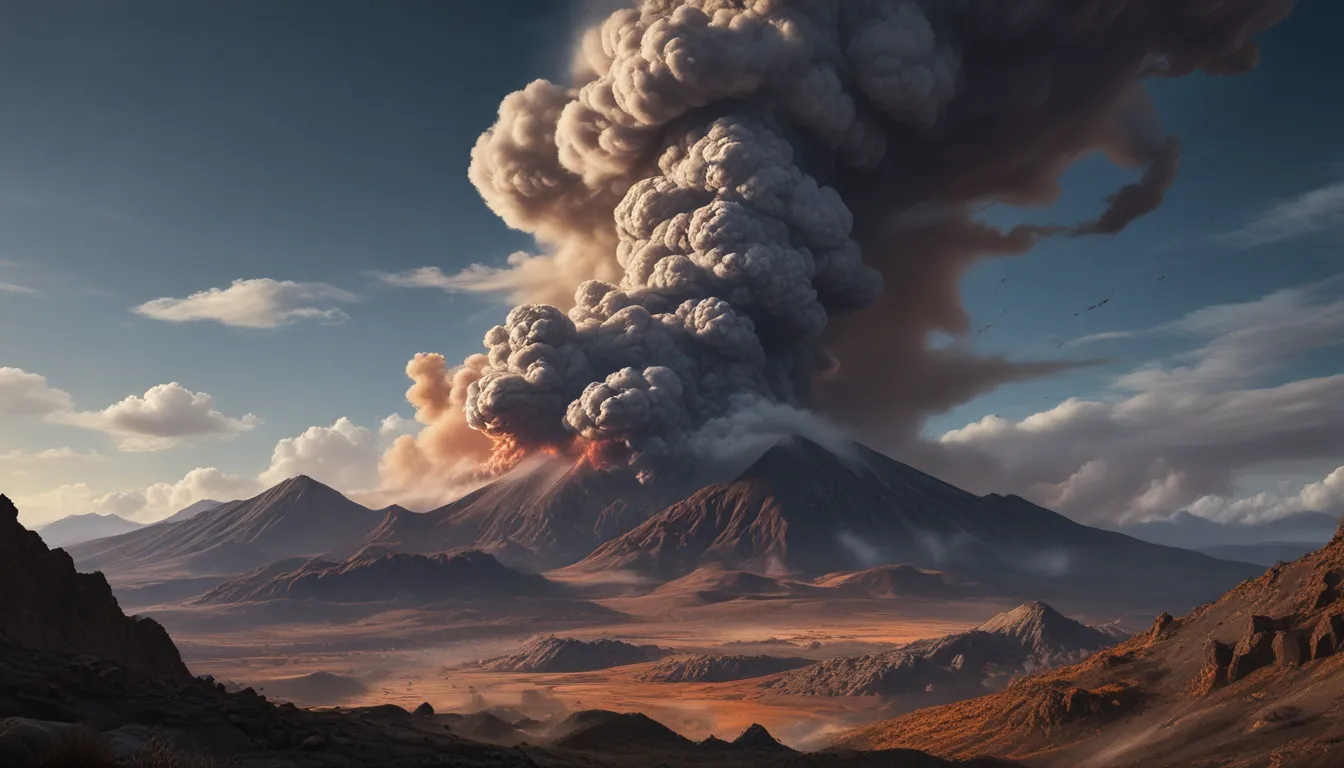A Note About Images: The images used in our articles are for illustration purposes only and may not exactly match the content. They are meant to engage readers, but the text should be relied upon for accurate information.
Volcanic eruptions stand as a testament to nature’s raw power, captivating us with their towering lava flows and billowing smoke. Amidst this spectacle, volcanic ash clouds emerge as an equally captivating phenomenon. Composed of tiny ash particles and gases expelled into the atmosphere during eruptions, these clouds hold a myriad of secrets waiting to be unearthed.
Unveiling the Mysteries of Volcanic Ash Clouds
Prepare to embark on an enlightening journey as we delve into 12 extraordinary facts about volcanic ash clouds that will leave you in awe. These ethereal formations wield a significant influence on climate, aviation, landscapes, and even agriculture, shaping our planet’s geological history in profound ways. Let’s dive into the intriguing world of volcanic ash clouds to expand our knowledge and appreciation for nature’s wonders.
Key Insights Into Volcanic Ash Clouds
- Global Impact: Volcanic ash clouds possess the remarkable ability to traverse vast distances, disrupting air travel, affecting weather patterns, and leaving a lasting impression on landscapes.
- Versatile Nature: Despite their destructive tendencies, volcanic ash finds practical applications in industrial realms, including cement production and cleaning, showcasing its multifaceted nature and utility in various industries.
The Astonishing Reach of Volcanic Ash
One of the most enthralling aspects of volcanic ash clouds is their extensive travel across thousands of kilometers. Carried aloft by powerful winds, these clouds can journey far and wide, exerting a global influence that transcends geographical boundaries and underscores the interconnectedness of our planet.
Navigating the Skies: Aviation and Volcanic Ash Clouds
Volcanic ash clouds present a formidable challenge to aviation, posing a substantial threat to aircraft safety. The minuscule ash particles can wreak havoc on engines, visibility, and navigation systems, prompting temporary closures of airports and airspace to ensure the well-being of passengers and crew.
The Cooling Effect: Weather Impacts of Volcanic Ash
When volcanic ash permeates the atmosphere, it exerts a cooling effect on the Earth’s surface by reflecting sunlight back into space. This atmospheric interplay can lead to localized temperature reductions following significant volcanic eruptions, showcasing the intricate relationship between volcanic activity and weather dynamics.
The Intricate Composition of Volcanic Ash
Contrary to common misconceptions, volcanic ash isn’t akin to the remnants of a campfire. Instead, it comprises tiny glass shards and rock fragments resulting from explosive volcanic eruptions. Ranging from fractions of a millimeter to several centimeters in diameter, these particles are instrumental in shaping landscapes and influencing ecosystems.
Balancing Acts: Health Impacts and Aesthetic Marvels
While volcanic ash clouds can evoke respiratory distress in humans and animals, they also bestow upon us stunning sunsets with their light-scattering properties. Despite their potential harm to agriculture, these clouds infuse the sky with a palette of vibrant hues, showcasing nature’s ability to blend beauty with adversity.
Tapping into Industrial Potential: The Practical Uses of Volcanic Ash
Beyond their destructive potential, volcanic ash particles find applications in various industrial sectors, serving as crucial components in cement, ceramics, and cleaning products. This duality of utility underscores the intricate balance between nature’s destructive forces and humanity’s innovative endeavors.
Thunderous Ovations: Lightning Storms and Volcanic Ash Clouds
The accumulation of electric charge within volcanic ash clouds can trigger the formation of lightning storms during volcanic eruptions. This natural spectacle, fueled by static electricity generated from ash particle interactions, adds a dramatic flair to the volcanic narrative, showcasing the awe-inspiring power of nature’s elemental forces.
Navigating Through Adversity: Resilience in the Face of Disruption
Despite the disruptions caused by volcanic ash clouds in satellite communication and agriculture, humanity’s resilience shines through as we adapt to these challenges. By understanding and mitigating the risks associated with volcanic ash, we forge pathways toward sustainable solutions and innovative advancements in technology and industry.
Embracing the Future: Insights and Discoveries
In conclusion, the 12 captivating facts about volcanic ash clouds unveil a rich tapestry of natural wonders that captivate and inspire us. From their global reach and atmospheric impacts to their industrial applications and creative potentials, volcanic ash clouds stand as a testament to nature’s boundless creativity and resilience.
Inquisitive Minds: Frequently Asked Questions
-
What initiates the formation of volcanic ash clouds?
Volcanic ash clouds originate from volcanic eruptions, releasing a mixture of gas, lava fragments, and fine ash particles into the atmosphere, propelled by winds over vast distances. -
Are volcanic ash clouds hazardous to human health?
Indeed, volcanic ash clouds pose significant risks to human health, aviation, and the environment. Inhaling volcanic ash particles can lead to respiratory issues and pose challenges to various sectors. -
How long can volcanic ash clouds persist in the atmosphere?
The duration of volcanic ash clouds varies based on eruption intensity, atmospheric conditions, and wind patterns. Some clouds dissipate swiftly, while others may linger for days or even weeks. -
Can volcanic ash clouds influence weather patterns?
Volcanic ash clouds can impact weather dynamics by reflecting sunlight, altering cloud formation, and influencing precipitation patterns in surrounding regions, showcasing their multifaceted environmental effects. -
Is it possible to predict the behavior of volcanic ash clouds?
Scientists utilize a range of monitoring technologies, including satellite imagery and computer models, to forecast volcanic ash cloud movements. However, predicting eruptions and atmospheric behaviors remains a complex endeavor that demands continuous vigilance and analysis.
Embracing Diversity: Your Source for Credible Insights
Our commitment to delivering authentic and enlightening content resonates through every fact and discovery shared on our platform. Each insight, contributed by individuals like you, undergoes meticulous review by our dedicated editors to uphold the highest standards of accuracy and reliability. Delve into a realm of diverse knowledge and enrich your understanding of the world with our trustworthy resources.
Through the lens of volcanic ash clouds, we uncover a world teeming with wonder, complexity, and resilience. As we navigate the realms of science and nature, let us embrace the intriguing nuances of volcanic phenomena, marvel at their transformative power, and forge a path toward deeper appreciation and stewardship of our planet’s diverse ecosystems.






